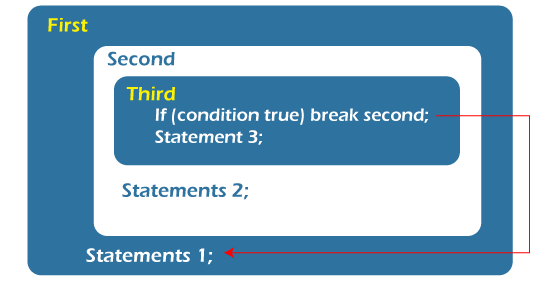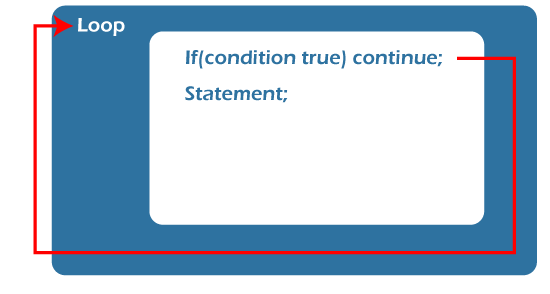Break Vs. Continue in C
Understanding the Difference Between a Break and a Continue Statement
Both statements are of the same type, and they allow a user to change or alter the flow of a programme. They are, however, distinct. The main difference between the break and continue statements in C is that the break statement causes the innermost switch or enclosing loop to exit immediately. The continue statement, on the other hand, starts the next iteration of the while, for, or do loop. The continue statement immediately takes control of the test condition in while and do loops. In the case of a for loop, it also takes control of the loop’s increment step.
The continue statement can only be used on loops and not on switches. When a continue is present inside a switch (or further inside a loop), the next loop is iterated.
If we want to exit after the execution of a specific case, we can use a break in the switch. In the case of a loop, the break is also useful when we want to exit the loop after a certain condition occurs. For example, if you reach the end of your data or an error condition too soon. We only use the continue statement when we want to skip a statement (or multiple statements) in the body of a loop and pass control to the next iteration.

Break is defined as
Break has only two uses in C++, the first of which is to “end the execution of a case in a switch statement.” The second step is to “end the loop and resume control to the next statement after the loop.”

In C++, the break statement is used.
Let’s take a closer look at each use of the ‘break’ statement. To begin, use to end the case execution in a switch. Only the switch that surrounds it is affected by the ‘break’ in the switch. It has no effect on the switch’s enclosing loop.
Continue is defined as
Breaking the loop terminates the remaining iterations and allows the control to exit the loop. Continue working in this manner as a break. The continue statement halts the execution of any remaining code in the loop for the current iteration and returns control to the loop’s next iteration.
The continue statement skips the current iteration’s code and passes control to the loop’s next iteration.

C++ Continue Statement
Let’s look at an example of how to use the ‘continue’ statement in C++.
With a ‘for’ loop, the effect of the continue statement is enhanced. While the continue statement is likely to execute the update statement in the case of while and do…while, this is not guaranteed.
In C, what is the difference between a break and a continue statement?
| Parameters | Break Statement | Continue Statement |
|---|---|---|
| Construct a loop. | This statement allows a user to exit a loop’s overall structure. | It does not allow a user to exit an overall loop structure. |
| Statements that switch and loop | The break statement can be used in conjunction with the switch statement. It can also be used inside the while loop, do-while loop, and for loop. It means that both the loop and the switch can easily break. | The switch statement and the continue statement are incompatible. You can still use it in for loops, do-while loops, and while loops. This means that continue can only happen in a loop, not in a switch. |
| Control | When the control reaches the break statement in a loop construct, it exits immediately. | The control passes from the beginning of a loop statement to the continue statement as soon as it encounters it. |
| Function | The break statement causes a loop or a switch to stop running in the middle of a case’s execution. It means that if a switch or a loop encounters a break, it will end abruptly. | The continue statement does not end the loop, but rather leads it to the next iteration. It means that if a loop encounters a continue statement, it will complete all of its iterations. The continue statement is used to skip the statements that follow the continue in a loop. |
| Syntax | It can be written as: break; | It can be written as: continue; |
The Key Differences Between Break and Continue
- In a nutshell, the break keyword ends the loop’s remaining iterations. The continue keyword, on the other hand, only ends the loop’s current iteration.
- When the break keyword is used, the program’s control exits the loop and moves on to the next statement after the loop. The control of the programme resumes to the next iteration of the loop if the continue keyword is used.
- As the preceding step concludes, when the break control of the programme is executed, the programme exits the loop. It is clear that break causes any loop to terminate early. Continue, on the other hand, only terminates the current iteration and resumes the loop’s next iteration, so we can say that continue causes the loop’s next iteration to be executed sooner.
- After it is executed, the break keyword terminates all remaining iterations, effectively stopping the loop from continuing. The continue keyword, on the other hand, keeps the loop running.
- The break keyword can be used with both “switch” and “label” statements. The continue keyword, on the other hand, cannot be used with “switch” or “label.”
Conclusion
Both the break and continue statements are jump statements that move control to another section of the programme. Whereas the break statement allowed the control to exit the loop, the continue statement allowed the control to enter the loop’s next iteration.
